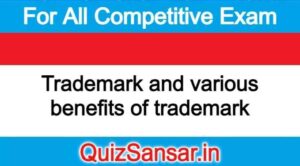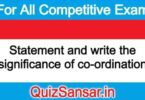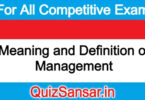
Trademark and various benefits of trademark
Meaning of Trademark
A registered trademark can be protected in perpetuity or indefinitely as long as the mark continues to perform its indicated function. A trademark is any word, name, symbol, or distinguishing device, or any combination thereof adopted and used by a manufacturer or merchant to identify his her goods and distinguishes them from those manufactured or sold by others.
Examples of trademarks are ‘Coke’ as a name used by Coca-Cola Corporation and ‘Apple’ with a bite in the side as a symbol trademarked by Apple Computer Corporation. An essential qualification for a trademark is that the name, symbol, or insignia must be used commercially on a continuous basis. For example, the trademarked name ‘Coke’ has been in continuous use since its inception.
Categories of Trademarks
The protection awarded is dependent on the character of the mark itself. There are four categories of trademarks:
1. Coined marks denote no relationship between the mark and the goods or services (e.g., Bata, Kodak) and afford the possibility of expansion to a wide range of products.
2. An arbitrary mark is one that has another meaning in our language (e.g., Apple) and is applied to a product or service.
3. A suggestive mark is used to suggest certain features, qualities, ingredients, or characteristics of a product or service (i.e., Halo shampoo). It differs from an arbitrary mark in that it tends to suggest some describable mattribute of the product or services.
4. A descriptive mark must have become distinctive over a significant period of time and gained consumer recognition before it can be registered. The mark then is considered to have secondary meaning, that is, it is descriptive of particular product or service (e.g., Rubberoid as applied to roofing materials that contain rubber).
Benefits:
A registered trademark offers significant benefits to the entrepreneur or proprietor.
Benefits of Registered Trademark :
a. It provides notice to everyone that you have exclusive rights to the use of the mark throughout the territorial limits of the country.
b. It entitles one to sue in the court for trademark infringement, which can result in recovery of profits, damages, and costs.
c. It establishes incontestable rights regarding the commercial use of the mark. customs to prevent
d. It establishes the right to deposit registration with importation of goods with a similar mark.
e. It entitles one to use the notice of registration.
f. It provides a basis for filing trademark application in foreign countries.
Registration of Trademark
Like patents, registration of a trademark involves a process consisting of three stages as follows:
1. Written Application, 2. Drawing Preparation, 3. Specimen Preparation. A brief description about each of these follows:
1. Written Application: The registration process of a trademark starts with submitting an application in the Patent Office in the standard form. The applicant needs to provide the conventional information such as name, address, citizenship, identification of partners (in case of Partnership firm), and company name. In addition, the applicant also must make a declaration clearly stating the individual or company that claims proprietary ownership. Also, the applicant must declare that a trademark has been adopted and the date on which the trademark was first used commercially. This defines the beginning of the term of protection in the event of any modification or disputed claims. The application is signed by the applicant, company officers, partners, owners of firm, or association officers, and is notarized.
2. Drawing Preparation : At this stage, a formal drawing on a good quality white paper using permanent black India ink is prepared. Drawing preparation does not require any engineering credentials of skills. The applicant simply needs to provide an accurate and clear drawing of the mark he/she wishes to protect.
3. Specimen Preparation: The applicant needs to prepare the five specimens of actual trademarks or facsimiles and submit the same with the application. Facsimiles are allowed because actual specimens can seldom be filed in a folder. The Academy Awards Oscar figurine, for example, is registered through validated photographs. But, specimens and facsimiles must be capable of photocopying and also fit onto a legal size format.
Issue of Trademark
Once the application is found complete and correct, the Patent Office will register a trademark. The Office will issue three copies of the registration to the applicant and the date trademark starts for tracking the protection period.
Following is a case of misuse of trademark.
Rediff vs. Radiff:
It is well known that Rediff.com is one of the leading Indian websites. It was founded in 1996 and is headquartered in Mumbai. It provides e-mail, messaging services, shopping facility, and news. It has over 250 employees and boasts of over 50 million online users.
One of the most significant challenges it faced was in 1990, when a website named radiff.com appeared on the scene. People at rediff.com got worried that radiff.com might be trying to cash in on the brand created by rediff.com. Firstly, users who have typed in the domain name wrongly can land up in radiff.com. There was also a possibility that consumers can get confused between the two similar sounding names. Very soon, rediff.com filed a suit against Cyber-tooth, the company behind radiff.com.
The defense put up by Cyber-tooth was primarily based on the following points:
(a) The word ‘radiff, is made-up by taking the first three letters of the word ‘radical’ and the last letters of the words ‘information.’ ‘future,’ and ‘free.” Its origins have nothing to do with rediff.com.
(b) The domain name ‘radiff.com’ has been registered with NIS, the official agency for registering domain names.
(c) The two websites are engaged in entirely different businesses. Rediff.com is a portal that offers a variety of services, including e-mail, shopping, and messaging, whereas radiff.com just provides hyperlinks to the websites of its advertisers.
(d) The web user is an aware and sophisticated individual and will not be confused by the alleged similarity in the names..
(e) The court was not convinced by the arguments put forth by Cyber tooth, and it ruled in favour of rediff.com. Cyber-tooth was given three months to remove the website.






